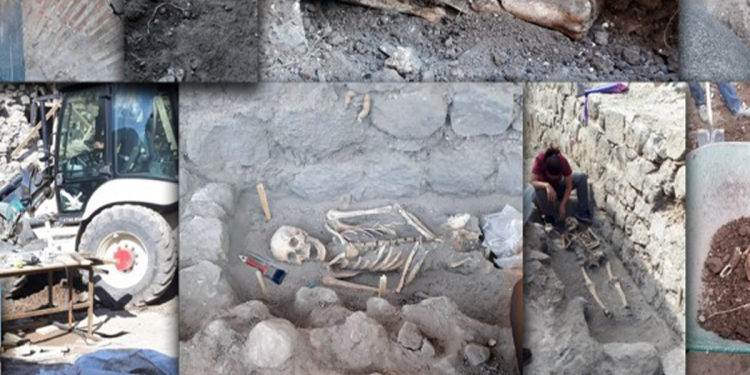AMED – Mesopotamya news agency has reported in an article that two human skeletons and many human bones were found next to Saray Kapi prison in Sur, Amed.
HUMAN REMAINS REFERRED TO AS ANIMAL BONES
The bones were found during the “restoration work” of YSO Construction Corporation in Cevatpaşa district, where, according to workers, they were called “animal bones” and were loaded on dump trucks. But after a while, this time human skeletons were found and they understood that the bones found before were also human bones. The workers explained that the bones were loaded on trucks, but they did not know where they were taken. Ahmet Kayar, who has been working under the auspices of YSO Construction Joint Stock Company for some time, told Mesopotamya news agency what he saw with his own eyes.
Kayar explained that in February he worked on the towers in the Cevatpaşa neighborhood, which the company has titled numbers 75-76. Kayar informed that the excavations in the area were carried out with working machines and bones were found during the work. Kayar said, “Bones were found all the time. We were told to throw them in the garbage. But our conscience did not accept that and we objected. After we were told that they were the bones of animals, we threw them in the garbage after all .”
Further, employee Ahmet Kayar explained that when they started working two meters away from Saray Kapi Prison, they kept finding skeletons and bones of people and said, “This time, more bones came out. We didn’t expect them to be human.” He explained that they were told that the work would be delayed if it was human bones and they actually came across human skeletons afterwards. Ahmet Kayar further explained that the skeletons found were shown to archaeologists and continued, “The archaeologists said that these are human (male) bones. Among the skeletons, other bones were found.” He explained that they had also asked who these bones belonged to, but had not been answered.
DESTRUCTION OF IMPORTANT HISTORICAL ARTIFACTS
Kayar described that important historical monuments of the city were destroyed during the construction work, explaining, “A lot of history was destroyed by the use of construction machinery. For example, there were ancient water pipes. They were constantly damaging such structures just so that the work at the construction site would not be disturbed. We were told, ‘Destroy them, make them disappear, otherwise our company won’t move forward.’ Otherwise we’ll have to document them first to be able to remove them.’ We discovered a historic basin. We filled that back up so it wouldn’t be seen. Scaffolding was then put on top of it. Great damage was done to the cultural heritage to hide it.”
Ahmet Kaya also reported that historical artifacts were partially destroyed under the supervision of the responsible persons while the workers were on their lunch break and pointed out that even the museum management had been on site and had seen this, but had closed its eyes to it. He demanded that measures be taken against this destruction.
PRISON FORMER JITEM BASE
The destroyed prison, next to which countless human bones were found, was used as a JITEM base in the 1990s. Thousands of people were deported there and their fate remained unknown. As early as 2012, human remains were found there during excavations, but despite the city’s Attorney General’s Office taking note, no investigation was launched. Jitem are a special unit of the Turkish military police responsible for intelligence gathering and counterterrorism. Especially in the 80s and 90s, thousands of people were abducted and murdered by this organization. To this day, it is not known exactly how many have fallen victim to this dirty war. Many of those whose fate remains unknown were buried in mass graves, caves, disused industrial plants or thrown into garbage dumps, well pits and acid pits. The abducted people were predominantly Kurds who were accused of being active for the PKK.




